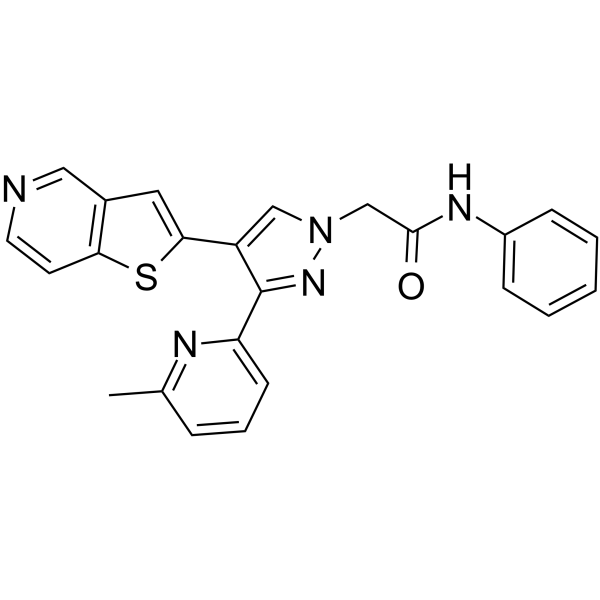| Description |
J-1063 is a potent, selective and orally active ALK5 inhibitor with an IC50 of 0.039 µM. J-1063 shows anti-fibrotic effect by the inhibition of inflammatory infiltration, collagen deposition, and hepatocytes necrosis. J-1063 has the potential for the research of liver fibrosis[1].
|
| Related Catalog |
|
| Target |
IC50: 0.039 µM (ALK5)[1]
|
| In Vitro |
J-1063 (compound 4) (10 mM) shows significant ALK5 inhibitory activity (IC50s of 8.12 and 0.039 µM for p38α MAP kinase and ALK5, respectively)[1]. J-1063 (2.5, 5, 10 µM; 1 h) improved fibroblast differentiation induced by TGF-β in LX-2 cells[1]. J-1063 (2.5, 5, 10 µM; 1 h) inhibits the inflammatory response induced by TGF-β[1]. J-1063 inhibits liver fibrosis by regulating TGF-β/Smad signaling and inhibits the activation of NLPR3-Caspase-1 inflammasome[1]. J-1063 (12.5 mg/kg; Cxcl1, Cxcl2 cells) inhibits the infiltration of macrophages and neutrophils during liver fibrosis[1]. Western Blot Analysis[1] Cell Line: LX-2 cells Concentration: 2.5, 5, 10 µM Incubation Time: 1 h Result: Inhibited the inflammatory response induced by TGF-β.
|
| In Vivo |
J-1063 (12.5, 25, 50 mg/kg; i.g., one time per day for two weeks) shows no toxic side effects on mice at low dose and is suitable for therapeutic administration[1]. J-1063 (12.5 mg/kg; p.o., daily for two consecutive weeks) shows benefit for TAA-induced liver fibrosis in mice[1]. Animal Model: Male C57BL/6 mice[1] Dosage: 12.5, 25, 50 mg/kg Administration: i.g., one time per day, two weeks Result: Showed no toxic side effects on mice at low dose and was suitable for therapeutic administration. Animal Model: Male C57BL/6 mice[1] Dosage: 12.5 mg/kg Administration: p.o., daily for two consecutive weeks Result: Showed benefit for TAA-induced liver fibrosis in mice.
|
| References |
[1]. Zheng GH, et al. The in vitro and in vivo study of a pyrazole derivative, J-1063, as a novel anti-liver fibrosis agent: Synthesis, biological evaluation, and mechanistic analysis. Bioorg Chem. 2022; 122:105715.
|
